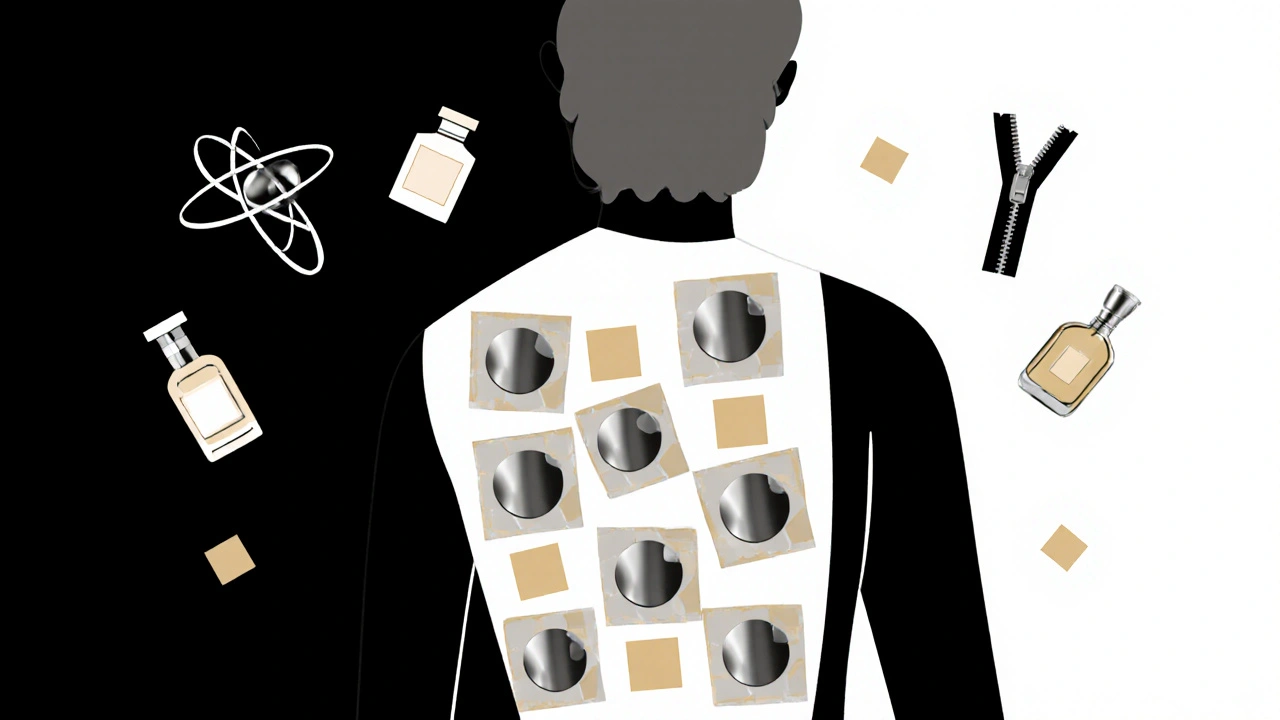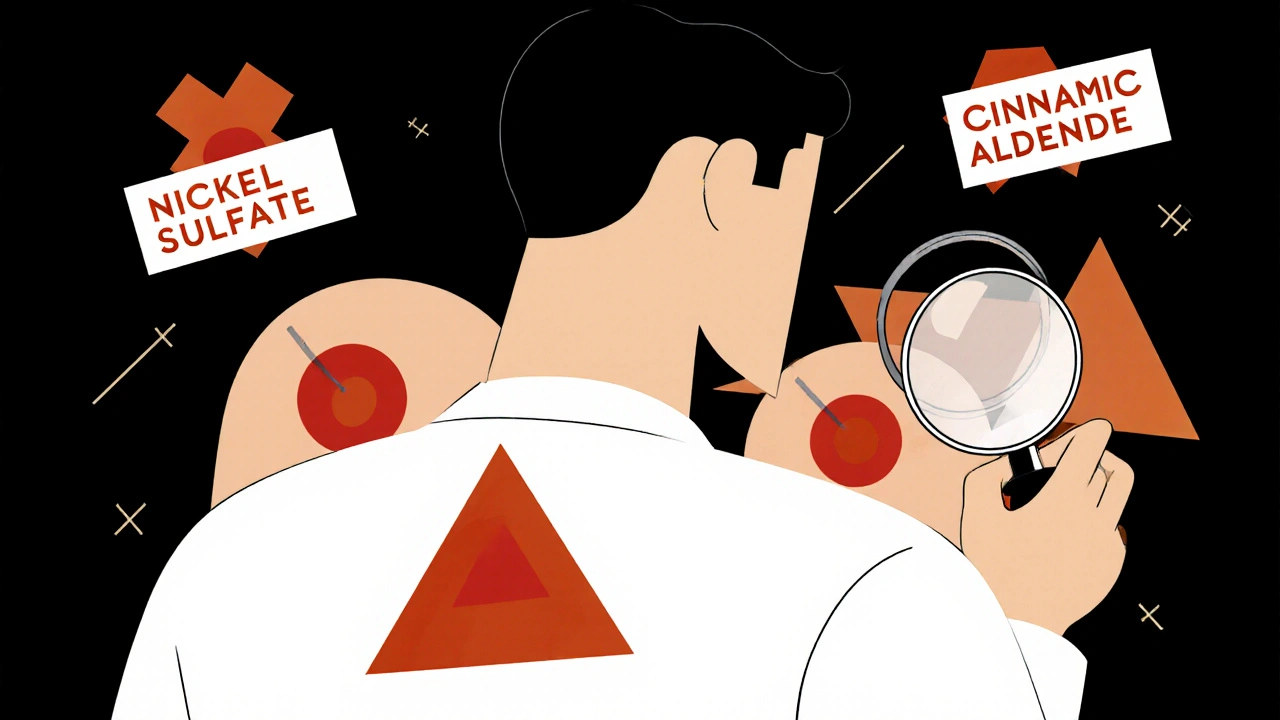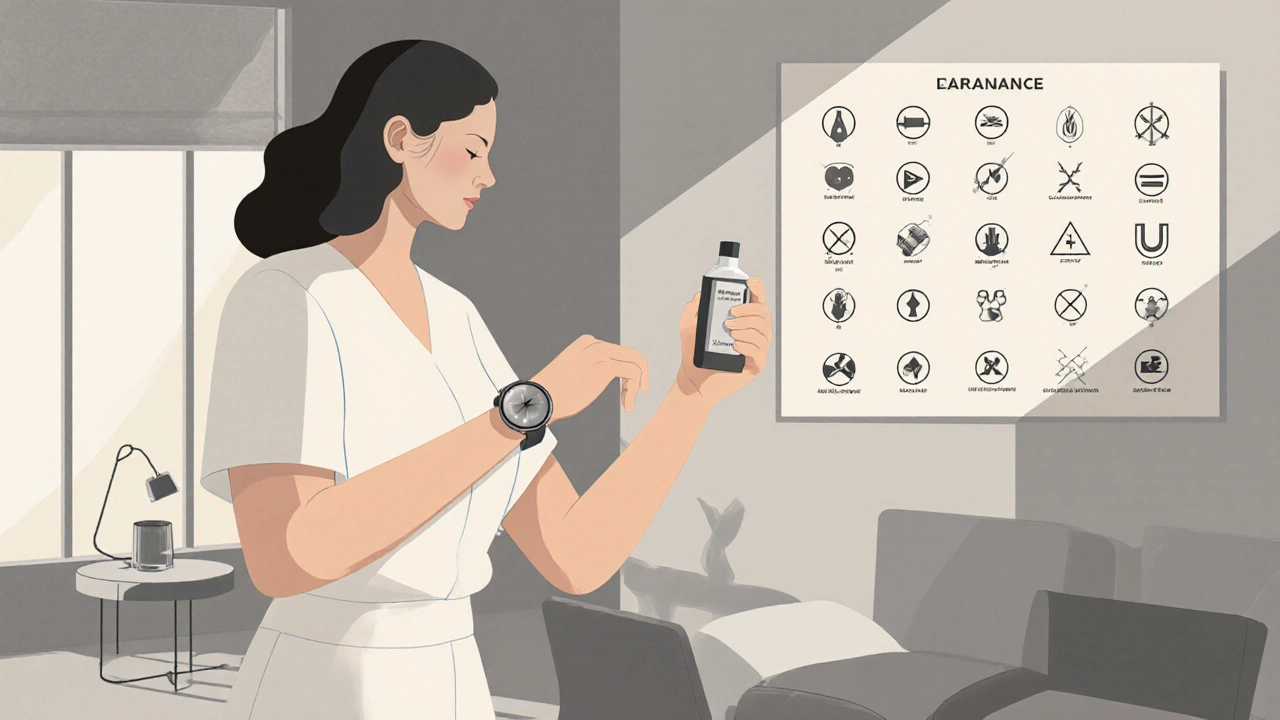Contact Allergy: Patch Testing for Metals and Fragrances
 Nov, 19 2025
Nov, 19 2025
If you’ve had a stubborn rash that won’t go away-no matter how many creams you try, how many times you change your soap, or how carefully you avoid known irritants-you might be dealing with a contact allergy. Unlike immediate allergic reactions like hives or sneezing, contact allergies develop slowly. They’re caused by your immune system reacting to something touching your skin, often after months or even years of exposure. The most common culprits? Metals like nickel and fragrances in lotions, perfumes, and even laundry detergent.
What Is Patch Testing?
Patch testing is the only reliable way to find out what’s causing your skin to react. It’s not a needle, not a blood test, and not a quick scratch. Instead, tiny amounts of potential allergens are taped to your back and left there for two full days. After that, your doctor checks for reactions. It’s simple, but it works.
This method was developed in the 1930s and has been refined over decades. Today, it’s the gold standard for diagnosing allergic contact dermatitis. Unlike other tests that look for immediate reactions, patch testing catches delayed-type hypersensitivity-where your T cells react to allergens over time. That’s why rashes from nickel in your watchband or fragrance in your shampoo don’t show up right away. They build up.
Why Metals and Fragrances Are the Top Triggers
Not all allergens are created equal. In North America, nickel is the #1 cause of contact allergy. About 1 in 5 people tested show a reaction to nickel sulfate. It’s everywhere: jewelry, belt buckles, zippers, coins, even some eyeglass frames. Cobalt and chromium are close behind, often found in cement, leather, and metal tools.
Fragrances are trickier. They’re not one thing-they’re hundreds of chemicals. Even products labeled "fragrance-free" can contain hidden sensitizers. The European Union requires 26 fragrance allergens to be listed on labels if they’re above certain levels. In the U.S., there’s no such rule yet. But patch testing can catch them.
Here’s the catch: testing only for "fragrance mix" isn’t enough. Studies show that 10-15% of people with fragrance allergies won’t react to the mix alone. That’s why modern patch testing includes individual chemicals like cinnamic aldehyde, lyral, and Myroxylon pereirae (balsam of Peru). These are common in cosmetics, shampoos, and even baby wipes.
How the Test Works
The process takes about a week and involves three visits.
- Day 1 (Application): A technician applies 80-120 allergens in small chambers to your upper back. Each chamber holds a tiny amount of substance-nickel sulfate at 5%, cobalt chloride at 1%, and so on. The patches are held in place with hypoallergenic tape.
- Day 3 (First Reading): After 48 hours, the patches are removed. Your doctor checks for redness, bumps, or blisters. A reaction at this point means you’re likely allergic.
- Day 5 (Final Reading): Some reactions appear later. A second check at 72-96 hours catches those. In rare cases, a final reading at 7 days is needed.
Reactions are graded on a scale: negative, doubtful, weak positive, strong positive, extreme. A strong positive means you’re definitely allergic. A weak positive might mean you’re sensitive but not severely affected.
During those 48 hours, you can’t get the patches wet. No showers, no swimming, no sweating. You wear loose cotton shirts. No bending over or scratching. It’s inconvenient, but it’s necessary. If you remove a patch early, the test is invalid.
Why It’s Better Than Guessing
Most people assume they know what’s causing their rash. "It’s the new soap." "It’s the laundry detergent." But studies show patient guesses are wrong 60-70% of the time. One study found that only 30-40% of people correctly identified their trigger just from their own history.
Patch testing has a 95-98% specificity rate. That means if it says you’re allergic to nickel, you almost certainly are. And if it says you’re not, you probably aren’t. Blood tests like lymphocyte transformation tests (LTT) are not reliable for fragrance allergies. They miss too many cases.
One nurse in Ohio had hand eczema for 12 years. She changed soaps, wore gloves, avoided water. Nothing worked. Patch testing showed she was allergic to nickel in her surgical scrubs and instrument clips. After switching to nickel-free alternatives, her skin cleared up completely.

What Happens After the Test?
Getting a diagnosis is only half the battle. The real win is avoiding the allergen.
If you’re allergic to nickel, you’ll need to stop wearing cheap jewelry, check your phone cases, and avoid metal buttons. Nickel-free options exist-stainless steel, titanium, or plastic-coated items. For fragrances, read labels carefully. Avoid products with "parfum," "fragrance," or "essential oils." Look for brands that list all 26 EU-required allergens.
Studies show that 60-80% of patients see their rash disappear entirely once they avoid their triggers. That’s not a miracle cure-it’s science. Avoidance works.
But here’s the problem: many people get tested with only the basic panel. If fragrance allergens aren’t included, they’ll keep getting rashes and wonder why. That’s why comprehensive testing matters. The North American Contact Dermatitis Group now includes 15 individual fragrance chemicals beyond the mixes. The European series has even more.
Common Problems and Misconceptions
Not every red spot means allergy. About 5-10% of reactions are irritant-not allergic. That’s why the test must be read by a trained dermatologist. A strong red patch might just mean the tape was too tight or you sweated under it.
False negatives happen too. About 22% of patients in one survey reported negative results but still had symptoms. That’s often because they didn’t get the full fragrance panel. Or they were tested too soon after using steroids on their skin. Steroids can suppress reactions, so you need to stop them for at least two weeks before testing.
Another myth: "hypoallergenic" means safe. It doesn’t. The term isn’t regulated. A product can be labeled hypoallergenic and still contain balsam of Peru or citral. Only patch testing can tell you what’s really triggering your skin.
Who Should Get Tested?
You should consider patch testing if:
- Your rash lasts more than a few weeks
- It’s on your hands, face, neck, or ears
- It flares up after using certain products
- Over-the-counter creams don’t help
- You’ve tried everything and still have symptoms
It’s especially important if you work with metals (hairdressers, mechanics, nurses) or use a lot of skincare, makeup, or perfumes. Even if you think you’re avoiding allergens, you might not know what you’re being exposed to.

The Future of Patch Testing
Research is moving forward. In 2023, the North American Contact Dermatitis Group added eight new fragrance allergens to their panel-citral, farnesol, and others that are becoming more common in modern products. The European baseline series now includes 32 fragrance markers.
Scientists are also exploring peptide-based tests for metal allergies. These could one day supplement patch testing with faster, less invasive results. But for now, patch testing remains the only proven method.
Meanwhile, demand is rising. Over 5.7 million patch tests were done in the U.S. in 2023, up 4.2% from the year before. As fragrances get more complex and metal use grows in consumer electronics, more people will need this test.
Frequently Asked Questions
How long does a patch test take?
The full process takes about a week. You’ll have three visits: one to apply the patches (Monday), one to remove them and check for early reactions (Wednesday), and a final check at 72-96 hours (Friday). Some clinics may schedule a fourth visit if delayed reactions are suspected.
Is patch testing painful?
No. The patches are taped to your back and don’t involve needles or pricking. You might feel slight itching or burning if you’re allergic, but that’s the reaction itself-not the test being painful. Most people describe it as an uncomfortable but bearable experience.
Can I shower during the test?
No. You must keep the test area completely dry for 48 hours. That means no showers, swimming, or sweating heavily. Most clinics recommend sponge baths only, avoiding the back. If the patches get wet or fall off, the test may need to be repeated.
What if I’m allergic to multiple things?
It’s common. Many people react to more than one allergen-like nickel and a fragrance chemical. Your doctor will help you prioritize which ones to avoid first. Some allergens are easier to avoid than others. For example, switching to nickel-free jewelry is simple. Avoiding all fragrances might require changing your laundry detergent, body wash, and even your partner’s perfume.
Are there any side effects?
The most common side effect is a temporary rash where the patches were. That’s expected if you’re allergic. In rare cases, the skin may darken or scar slightly, especially if you scratch. Some people get irritant reactions from the tape or pressure, but these are usually mild and fade within days.
Can I do patch testing at home?
No. Patch testing requires controlled allergen concentrations, standardized application, and expert interpretation. DIY methods or home kits are unreliable and can cause serious irritation or false results. Always see a board-certified dermatologist trained in patch testing.
How accurate is patch testing for fragrances?
It’s the most accurate method available. But accuracy depends on the panel used. Testing only with fragrance mixes misses 10-15% of cases. Comprehensive testing that includes individual chemicals like lyral, hydroxycitronellal, and cinnamic aldehyde increases detection to over 90%.
Will my insurance cover it?
Most insurance plans cover patch testing if it’s ordered by a dermatologist for suspected allergic contact dermatitis. However, coverage varies. Always check with your provider beforehand. Some clinics offer payment plans if cost is a concern.
What to Do Next
If you’ve been struggling with a rash that won’t go away, don’t keep guessing. Ask your dermatologist about patch testing. Bring a list of all the products you use daily-shampoo, lotion, deodorant, even your laundry detergent. The more info you give, the better they can tailor the test.
Don’t settle for temporary relief. You deserve to know what’s causing your skin to react-and how to stop it for good. Patch testing isn’t glamorous. It’s inconvenient. But for thousands of people, it’s the key to finally being free from constant rashes, itching, and frustration.

Ravinder Singh
November 19, 2025 AT 10:48Been dealing with this for years 😅 Finally got patch tested last year-turned out my cheap phone case was poisoning me with nickel. Switched to silicone, and my hands haven’t been red since. Life-changing. Also, avoid those "natural" essential oil soaps-they’re sneaky! 🌿
Russ Bergeman
November 20, 2025 AT 15:06Dana Oralkhan
November 21, 2025 AT 08:15I just want to say how much I appreciate this post. I had a rash for 8 years and thought I was just "sensitive." My dermatologist didn’t even mention patch testing until I asked. It’s not just about the test-it’s about being heard. If you’ve been struggling, please, advocate for yourself. You deserve relief.
Jeremy Samuel
November 21, 2025 AT 08:56Destiny Annamaria
November 23, 2025 AT 08:39OMG I JUST REALIZED MY LAUNDRY DETERGENT HAS FRAGRANCE IN IT?!?!? I’ve been using "free & clear" for years but I guess that doesn’t mean anything?!?!? I’m gonna switch to Seventh Generation NOW and report back. This is wild.
Ron and Gill Day
November 24, 2025 AT 10:48Alyssa Torres
November 25, 2025 AT 02:33I cried when I got my results. I had been allergic to MYROXYLON PEREIRAE for 15 years-found it in my favorite shampoo, my mom’s perfume, my baby’s wipes… I thought I was just "bad at skincare." Turns out I was just being slowly poisoned by everything labeled "gentle." This test didn’t just heal my skin-it healed my self-blame.
Summer Joy
November 25, 2025 AT 17:22Ugh I HATE when people say "it’s just a rash." Like I’m not sitting here scratching my neck raw at 3am while my partner sleeps peacefully unaware that his cologne is slowly turning my skin into a crime scene. 🤢
Aruna Urban Planner
November 27, 2025 AT 04:44From a systems perspective, the latency of delayed-type hypersensitivity reflects the neuroimmunological lag between antigen exposure and T-cell priming. The clinical utility of patch testing lies in its ability to map epidermal antigen-presenting cell dynamics. That said, accessibility remains a structural barrier-especially in low-resource settings where dermatology infrastructure is underfunded.
Nicole Ziegler
November 28, 2025 AT 04:34Bharat Alasandi
November 29, 2025 AT 00:35Bro, I work in a machine shop. Nickel’s everywhere. I got tested and found out I was reacting to my tool handles. Now I wrap everything in electrical tape. Cost me $10, saved my life. Also, avoid stainless steel with chromium-it’s a silent killer. Stay sharp, fam.
Kristi Bennardo
November 29, 2025 AT 10:28Shiv Karan Singh
December 1, 2025 AT 03:32Everyone’s acting like this is some breakthrough. Newsflash: we’ve known about contact allergies since the 1800s. You think you’re special because you found out your watch is the problem? Congrats. Now go buy a plastic one. Stop making this a TED Talk.